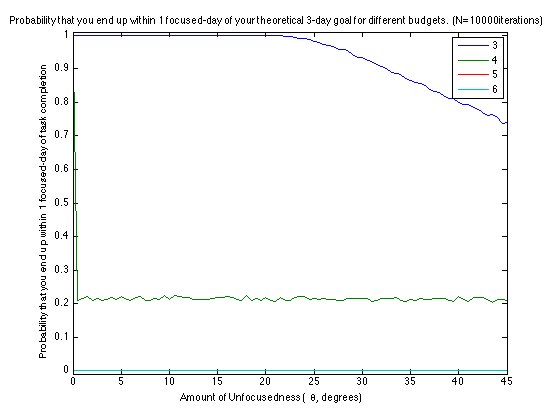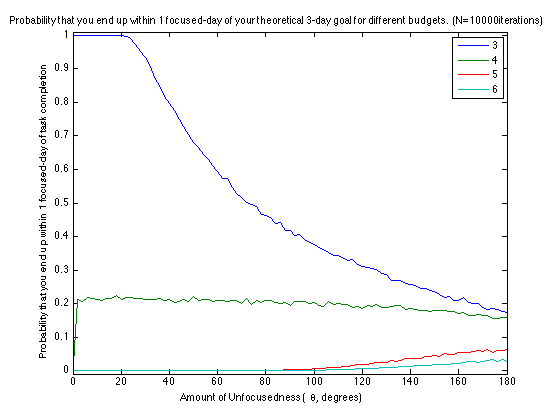|
You have a project that takes exactly 3 days to complete if you were to work on it in completely the "correct direction". That means that every effort spent on the project contributes 100% to reaching the project deadline. This is what it looks like when you spend one really good day working on the project. But in reality, you don't go in the right direction each day your work on it, for whatever reason. You become scatterbrained. You have lost focus. You are having a bad day. So when you do put a day's worth of effort into the project, you actually may go in the wrong direction. This is what could happen with 3 unfocused people. You could see that A and C are less focused than B, especially initially. After 3 days of work, you can measure the distance between their endpoints and the deadline (i.e. project objective). This distance can be considered the additional amount of work, in number of days, necessary to complete the deadline. Now that we know how far we are from the deadline, I describe "focus" by the parameter θ (theta). Large θ is not focused: it suggests you pursue work in deviated direction relative to the last day's work. Small θ is focused: it suggests you pursue work in a more aligned direction relative to the last day's work. So this model works by picking a a future point, 1 day away from yesterday, that falls within the angular range defined by θ, the parameter of "unfocusedness". The initial condition is that you start "facing" in the direction of the deadline. If you are perfectly focused then you would have θ = 0 for every day, like for the first day here: You could also think about a perfectly-focused model (θ = 0), as if your work efforts have no other "choice" but to contribute completely towards the deadline. That there is no "opportunity" for screwing around or deviating. For θ > 0, there are opportunities for distraction, for unfocusedness, like this: ASSUMPTIONS1. On the first day you start off "looking" in the direction of the deadline. This is like after you have had your briefing. You feel ready and focused! 2. Unfocusedness (θ) does not change during the entire duration of the work. This is likely unrealistic, because you usually check yourself to make sure you are heading in the right direction, and then have the opportunity to consciously "refocus". 3. The project deliverable does not change. This could also be realistic because sometimes the objectives of your project change. Sometimes in a highly-dependent objective, the objective changes as a function of what results you product in relation to the current context. "You are chasing a moving target". Therefore, this simple initial model assumes you have a fixed "unfocusedness" and are ignorant of how far you are from your objective at each day you work on it. And after B (budgeted) days you work in this manner, you then measure the distance the deadline objective. resultsSo I run this model 10,000 times for a set of parameters. There are three parameters to this model. 1. The minimum amount of time it takes to complete an objective (or project deadline). 2. The amount of time you spend working. 3. The amount of unfocusedness, θ. So for maximum interest, I hold parameter 1 fixed and change parameters 2 and 3. That is, I have no control over how difficult a project is; all I can control is how much time I budget for myself and how focused I am while working on it. (Really you can resolve the 3-parameter list to 2 parameters: parameter 3 and the ratio of parameter 2 to parameter 3, but this will be "simpler" if I keep all parameters separate and hold parameter 1 fixed). After B days working with θ focus, I measure the distance (in days) to the objective. I then do this 10,000 times (because each work day selects a new position within the uniform angular range defined by θ) and then I count the number of those 10,000 instances that end less than 1 day away from the objective. In other words, what are my chances that working this "unfocusedly", for B days, will get me within 1 day of my objective? Here are the results for B = 3, 4, 5, 6 days; and θ = 0 (perfectly focused) to 5 degrees (a little scatterbrained): Observations 1. After working 3 days for a 3-day task, and stay relatively focused (0 to 5 degrees) you will always end up within 1 day of the objective 2. After working 4 days for a 3-day task, you have a ~20% chance of every ending up within 1 day of the objective. Note, that if you are perfectly focused (θ = 0) and work for 4 days in the direction of the objective, you can "overshoot" the objective; this is why the B=4 line starts at 0%. 3. After working 5 and 6 days for a 3-day task, you will have overshot the objective all the time, so you there is a 0% chance that you would end at your objective. We can also look at the average distance (in days) from the objective after 10,000 instances. What is the expected distance (in days) from our objective we would reach after B days of working with θ amount of focus? Observations 1. After working 3 days for a 3-day task, the average distance from the objectives stays under 1/10th of a day even up to an unfocused level of 5 degrees. 2. After working 4 days for a 3-day task, you remain almost exactly 1 day away from the objective. 3. After working 5 and 6 days for a 3-day task, you will have overshot the objective all the time. In fact, for narrow focus parameter (0 to 5 degrees) we B=4 and greater will achieve similar distances to the objectives. Again, this model assumes no "reality checks", to assess how far you are away from the objective each day. A clear urge now is to ask: What would happen if you become less focused? Let's see: Observations 1. Beyond about 20 degrees of unfocusedness, for all 3 days working towards a 3-day task, there is less than a 100% chance you end up within 1 day of the objective. At 45 degrees of unfocusedness, there is a 73% chance you end up within 1 day of your objective. 2. Nothing noticeably changes for B = 4 and greater. This all makes sense. So let's get extreme. What about extreme unfocusedness? What about being so unfocused that you work on something that is completely uncorrelated (~180 degrees) from what your did yesterday? What about being so unfocused and manic that you actually go backwards (180 to 360 degrees)? Observations: Cool! A 4-day work effort starts to slowly decreases its chances as you become less and less focused. Cooler! Increasing unfocusedness (>90 degrees) starts to increase the chance that a 5-day and 6-day work effort reaches the objective. Coolest! All work efforts (B=3,4,5, 6) look like they are converging to the same percent. As you become less and less focused, the difference between working 3 days and working 6 days shrinks. Keep going. Let's be able to go backwards, manic, backtrack, until every direction is a possible result each and every day we work (θ = 360 degrees = model limit). For this parameter set, I increase the number of iterations to minimize the noisiness of these lines. (The results themselves are becoming less predictable as θ increases.) Remember when I said that it looks like chance of reaching within a day of the objective are converging for all B, as θ approaches 180 degrees? Well they don't actually converge as you lose focus. Observe the interesting crossovers for θ > 180. Observations. Using P(x) in place of "Chance of ending within 1 day of objective given x parameter"
1. P(B=3) drops below P(B=4) at θ>200 degrees; drops below P(B=5) at θ>270 degrees; and drops below P(B=6) at θ>290 degrees. 2. P(B=5) at θ>320 degrees; and drops below P(B=6) at θ>320 degrees. 3. P(B=5) looks like it might drop below P(B=6) for θ>320. Comments are closed.
|
Archives
May 2014
Categories |













 RSS Feed
RSS Feed